Paper ID: 140
EXTRACTION AND CHARACTERIZATION OF CELLULOSE FROM PANDANUS (PANDANUS TECTORIUS)
Authorship
Venty Suryanti1,*, Triana Kusumaningsih1, Indri Sri Cahyani1 and Diah Safriyani1
1Department of Chemistry, Faculty of Mathematics and Natural Sciences, Sebelas Maret University, Jl. Ir. Sutami 36A Surakarta 57126, Indonesia
venty@mipa.uns.ac.id
Abstract
Cellulose is abundant renewable carbon source which is widely distributed in plants. It is the most natural polymer which is considered a long-term renewable fossil fuel alternative as an environmental friendly substitute to petroleum based non-biodegradable materials. The cellulose conversion into derivatives has gained great interest in the fields of green and sustainable chemistry, and has proportioned the development of friendly environmental technologies. Pandanus (Pandanus tectorius) grows naturally in the tropics area, including Indonesia. Pandanus leaves can produce strong fibers that are used to make ropes, woven caps and mats. However, Pandanus is not quite profitable if only planted for the production of mats, beds, chairs, and baskets. Pandanus leaves have great potential as a source of cellulose. Research on the extraction cellulose from Pandanus leaves is still limited. The present study focus is to extract cellulose from Pandanus via fast and simple technique. The Pandanus leave powder was treated with alkali and then bleached to separate the cellulose from the lignin and hemicellulose. The extracted cellulose was characterized by modern analytical methods such as FT-IR, SEM and TG-DTA. This cellulose can be converted into its derivatives for industrial applications.
